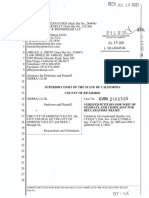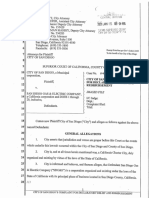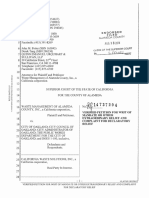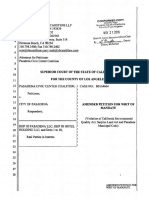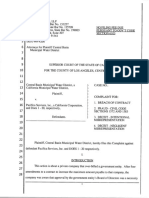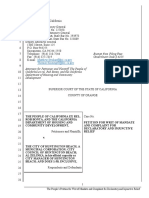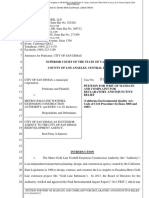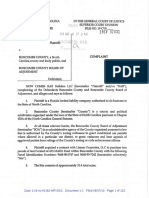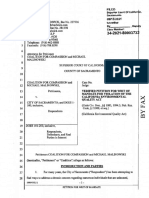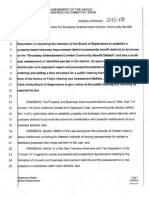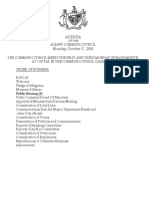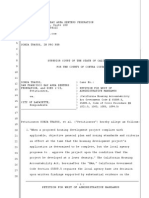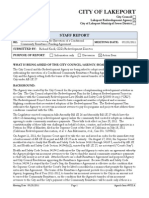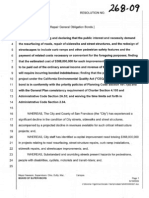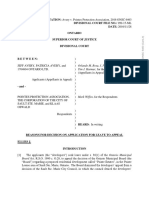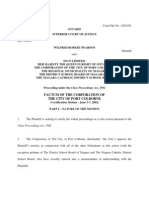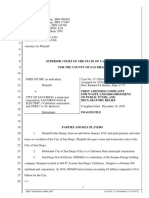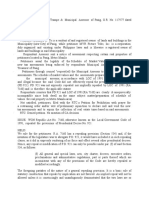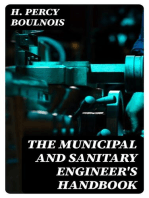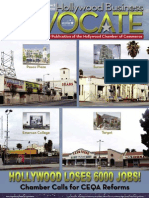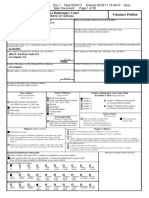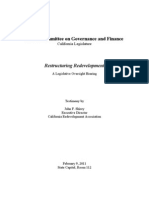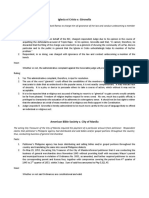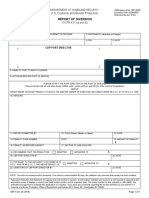Carstens 2 Chatten-Brown, Carstens, 3 4 CA 310.314.8040 Fax
Carstens 2 Chatten-Brown, Carstens, 3 4 CA 310.314.8040 Fax
Uploaded by
curbedlaOriginal Description:
Original Title
Copyright
Available Formats
Share this document
Did you find this document useful?
Is this content inappropriate?
Report this DocumentCopyright:
Available Formats
Carstens 2 Chatten-Brown, Carstens, 3 4 CA 310.314.8040 Fax
Carstens 2 Chatten-Brown, Carstens, 3 4 CA 310.314.8040 Fax
Uploaded by
curbedlaCopyright:
Available Formats
CHATTEN-BROWN & CARSTENS
2 Jan Chatten-Brown, SBN 050275
Douglas P. Carstens, SBN 193439
3 Arthur Pugsley, SBN 252200
2601 Ocean Park Blvd, Suite 205
4 Santa Monica, CA 90405
5 310.314.8040; Fax 310.314.8050
6 Attorneys for Petitioner
7 LA Neighbors United
9 SUPERIOR COURT OF THE STATE OF CALIFORNIA
10 FOR THE COUNTY OF LOS ANGELES
11
LA NEIGHBORS UNITED, an ) CASE NO.:
12 unincorporated citizens' association; )
)
13 ) PETITION FOR PEREMPTORY WRIT
Petitioner,
14 ) OF MANDATE
)
v.
15 )
)
16 CITY OF LOS ANGELES ) (CALIFORNIA ENVIRONMENTAL
) QUALITY ACT)
17 Respondent, )
18 ------------------------)
and DOES 1 to 10; )
19 )
Real Parties in Interest. )
20 )
21 )
)
22 )
)
23 )
24 --------------------------- -)
25
26
27
28
PETITION FOR WRIT OF, MANDATE;
1 INTRODUCTION
2 1. This action is brought pursuant to the California Environmental Quality Act
3 (CEQA) and challenges the approval of City of Los Angeles Ordinance No. 181412 (hereinafter,
4 "Community Plan Implementation Overlay Ordinance" or "CPIO Ordinance"), passed by the
5 Los Angeles City Council on November 10, 2010.
6 2. The CPIO Ordinance, according to the Planning Department staff report, is "part
7 of a suite of new zoning tools" under active consideration by the City. It establishes and defmes
8 a new Supplemental Use District (the CPIO District) to the Municipal Code.
9 3. The CPIO Ordinance amends Sections 12.04, 12.20.3, and 12.32 of the Los
10 Angeles Municipal Code, and adds a new Section 13.14 to the Los Angeles Municipal Code.
II 4. The CPIO Ordinance represents a sweeping change to the City's Zoning Code
12 with far- reaching land use, growth, transportation, housing, and environmental implications.
13 Indeed, the CPIO Ordinance is part of the biggest overhaul of the Los Angeles zoning code
14 since 1946. Yet the City refused to prepare an Environmental Impact Report (ErR) pursuant to
IS CEQA on such a large and far-ranging project. As a result, neither the City nor the public was
16 informed of the potentially significant environmental impacts associated with the CPIO
17 Ordinance or other aspects of the City' s overhaul of its zoning code prior to the City Council's
18 approval.
19 5. The Ordinance, by its own terms, is intended to "create an approval process to
20 enable infill development" and City planning staff has stated the CPIO is intended to be "used in
21 combination with existing regulations to tailor development standards within a Community Plan
22 area."
23 6. The Ordinance allows creation of CPIO districts with minimal public involvement
24 and of any size (i.e., the CPIO contains no minimum or maximum size requirements for a CPIO
25 District).
26 7. The CPIO Ordinance allows creation ofCPIO Districts anywhere in the City,
27 without respect to location near transportation or other infrastructure.
28
2 PETITION FOR WRIT OF MANDATE:
8. Once a CPIO District is established, the Zoning Administrator, an unelected
2 official in the City's Planning Department, will be able to grant administrative approvals, with
3 no public involvement, of projects as much as 20% denser than those allowed by the current
4 zoning code through a "sign-off' process.
5 9. The density of approved projects could even increase by more than the 20%
6 allowed by the "sign-off' process, since upon establishment of a CPIO District, zoning
7 variances would no longer be required for projects within the District. Rather, a proposed
8 development exceeding zoning limitations by more than 20% would only need to be granted an
9 exception to the CPIO District standards, which is subject to a lower standard for approval than
lOa varIance.
11 10. The Council adopted the Ordinance after placing it on the consent calendar,
12 frustrating those members of the public who had come to testify by denying the public even the
13 most minimal opportunity to directly confront their elected representatives on this matter of
14 City-wide importance.
15 11. Despite the refusal by the full City Council to allow live public testimony prior to
16 approving the CPIO Ordinance, Petitioner and others nonetheless submitted substantial evidence
17 to support a fair argument that the adoption of the Ordinance may have significant
18 environmental impacts.
19 12. The CPIO Ordinance is part ofa larger overhaul of the City' s zoning code that
20 currently includes nine potential zoning code revision ordinances and other zoning code changes
21 involving ground floor commercial uses and new pedestrian design standards, but the City did
22 not analyze the cumulative effects of the CPIO Ordinance with the other zoning code changes
23 under active consideration, or treat the various ordinances and other actions now under
24 consideration as components of an integrated zoning code overhaul. As these other ordinances
25 and actions are brought forward, Petitioner reserves the right to file Petitions challenging the
26 approval of the ordinances.
27
28
3 PETITION FOR WRIT OF MANDATE·
1 13. The City is also undertaking what it calls the "Do Real Planning" Initiative. The
2 CPIO Ordinance and other actions under consideration by the City are also apparently a part of
3 this wider initiative.
4 14. Because the record contains substantial evidence supporting a fair argument of
5 environmental impacts, the City's reliance on a Negative Declaration is improper. The City
6 violated CEQA by approving this Ordinance on the basis of a Negative Declaration, rather than
7 first preparing an EIR to fully inform it, and the public, on the potentially significant
8 environmental impacts of the CPIO Ordinance.
9
10 JURISDICTION
11 15. This Court has jurisdiction over the writ action under sections 1085 and 1094.5 of
12 the Code of Civil Procedure ("CCP"), and section 21168.5 of the Public Resources Code.
13
14 PARTIES
15 16. Petitioner is an unincorporated association whose mission is to ensure that City
16 land use decisions fulfill General Plan Framework mandates of planned, managed growth
17 supported by infrastructure, including transit infrastructure, and are made with the public
18 health, safety, and welfare as a priority. Petitioner' s members include residents and taxpayers
19 of the City of Los Angeles who will be adversely affected by impacts resulting from the
20 Ordinance described herein, and who are aggrieved by the acts, decisions and omissions of the
21 City of Los Angeles as alleged in this Petition. Petitioners bring this action as members of the
22 affected public, and in the interest of the general public.
23 17. Respondent City of Los Angeles is a political subdivision of the State of
24 California.
25 18. Real parties named as Does I to X are given fictitious names because their names
26 and capacities are unknown to Petitioner at present.
27 III
28 1//
4 PETITION FOR WRIT OF MANDATE -
STATEMENT OF FACTS
2
3 19. In March 2009, the City hosted a lone public outreach meeting on the subject of
4 the CPIO Ordinance.
5 20. The Planning Commission approved the Ordinance in May 2009.
6 21. The City Attorney approved the proposed text of the CPIO Ordinance as to form
7 on October 4,2010.
8 22. The City Council Planning and Land Use Committee approved the CPIO
9 Ordinance on November 2, 2010.
10 23. The City Council adopted the CPIO Ordinance on November 10, 2010.
11 24. A Notice of Determination was filed with the County Clerk on November 16,
12 2010.
13 25. The Mayor transmitted his signature of the CPIO Ordinance to the City Clerk on
14 November22,2010.
IS 26. The City is separately evaluating nine other Ordinances amending various
16 sections of the zoning code. The "Core Findings" Ordinance, for example, is scheduled for a
17 Planning Commission vote on January 13,2011.
18 27. This action was timely filed.
19
20 EXHAUSTION OF ADMINISTRATIVE REMEDIES
21 AND INADEQUATE REMEDIES AT LAW
22
23 28. Petitioner's members objected to the project in the administrative process and
24 fully exhausted their administrative remedies. Petitioner's members appeared at public
25 hearings raising the issues set forth in this Petition, and submitted written testimony, including
26 factually supported expert testimony.
27 29. Petitioner has no plain, speedy or adequate remedy in the course of ordinary law
28 unless this Court grants the requested writ of mandate. In the absence of such a remedy,
5 PETITION FOR WRIT OF MANDATE '
1 Respondent's approval of the CPIO Ordinance will form the basis for third parties proceeding
2 with development projects in violation of state law.
3 30. Petitioner is complying with Public Resources Code section 21167.7 and Code of
4 Civil Procedure section 388 by sending a copy of this petition to the California Attorney
5 General concurrent with the filing of this Pleading. (Exhibit A.)
6 31. Petitioner has complied with Public Resources Code section 21167.5 by
7 providing the City with notice of intention to commence this action. (Exhibit B.)
8 32. Petitioner elects to prepare the administrative record. (Exhibit C.)
9
10 FIRST CAUSE OF ACTION
11 (VIOLATION OF CEOA)
12
13 33. Petitioner incorporates all previous paragraphs as if fully set forth.
14 34. CEQA requires the City to conduct an adequate environmental review prior to
15 making any formal decision regarding discretionary projects subject to the Act (CEQA
16 Guidelines, 14 Cal. Code Regs. § 15004), unless a specific statutory or regulatory exemption
17 applies. No such exemption is applicable here.
18 35. The approval of the CPIO Ordinance by the City Council is a project within the
19 meaning of CEQA.
20 36. Approval of the CPIO Ordinance by the City Council is a discretionary action
21 subject to CEQA.
22 37. The City prepared an Initial Study to support its Negative Declaration, but the
23 Initial Study is little more than repetition of the boilerplate explanation that the CPIO Ordinance
24 will not have significant environmental impacts because the Ordinance does not in itself include
25 any proposals for physical development. The City completely ignores the indirect, but readily
26 forseeable, environmental impacts resulting from the city-wide development enabled by the
27 CPIO Ordinance.
28
6 PETITION FOR WRIT OF MANDATE ;
38. The threshold requirement for preparation of an EIR is low, "reflect[ing] a
2 preference for requiring an EIR to be prepared." (Mejia v. City of Los Angeles (2005) 130 Cal.
3 App. 4th 322, 332.) To prevail, Petitioner need not show that the CPIO Ordinance will have a
4 significant environmental impact, although significant impacts resulting from such a sweeping
5 change to the zoning code are highly likely. Petitioner need only show that the CPIO
6 Ordinance may have a significant environmental impact and that the record supports a "fair
7 argument" of such a potential impact. (Pub. Res. Code. § 21080 subd. (c), (d).)
8 39. In a situation such as here, where an agency approves a project while refusing to
9 conduct any studies of potentially significant environmental impacts, the scope of the "fair
10 argument" test is enlarged by lending a logical plausibility to a wider range of inferences.
11 (Sundstrom v. County of Mendocino (1988) 202 Cal. App. 3d 296,311.)
12 40. Petitioner presented numerous questions regarding the potentially significant
\3 impacts of the project to the City Council, but the City approved the project without answering
14 any of those questions. Nonetheless, despite the lack of City-sponsored studies in the record,
15 Petitioner submitted expert opinion supported by facts and reasonable inferences supporting a
16 fa ir argument that the approval of the CPIO Ordinance may have a significant environmental
17 impact.
18 41. The CPIO Ordinance, by its own terms, enables growth beyond that permitted by
19 existing zoning, by as much as 20% city-wide. Since the variance process is replaced within
20 CPIO Districts by a less stringent process of obtaining exceptions, growth even above and
21 beyond the additional 20% allowed by the terms of the CPIO Ordinance is forseeable. The
22 growth impacts and cumulative impacts of the CPIO Ordinance are thus potentially significant.
23 42. The City is undertaking a comprehensive overhaul of its zoning code, of which
24 the CPIO Ordinance is a part. However, the City has not discussed how the CPIO Ordinance
25 will work with the other elements ofthe initiative to facilitate new development throughout the
26 City. The cumulative impacts of the major zoning framework changes proposed by the City are
27 potentially significant.
28
7 PETiTiON fOR WRIT OF MANDATE;
43. The City has improperly piecemealed review of what amounts to a wholesale
2 rewriting of its zoning framework by approving the CPIO Ordinance separately from the other
3 proposed ordinances and other actions under consideration by the City.
4 44. The approval of the CPIO Ordinance has generated significant momentum for the
5 most significant rewriting of the Los Angeles Municipal Code since 1946. As one August 2010
6 newspaper article succinctly described the wholesale changes, "LA Hopes to Blow Up Postwar
7 Zoning Codes." The CPIO Ordinance is the opening volley in that campaign.
8 45. CEQA review must occur before a project takes on bureaucratic and financial
9 momentum, reducing any environmental review that eventually takes place to an exercise in
10 post hoc justification. (Laurel Heights Improvement Association v. Regents a/the University
II a/California (1988) 47 Cal. 3d 376, 395.) The City is unlikely to conduct detailed
12 environmental review of individual CPIO Districts, because the CPIO Ordinance allows the
13 City to designate individual (but nonetheless adjacent or conceptually related) districts of very
14 small size, allowing the City to claim that the impacts of that CPIO District designation are not
15 significant. In the alternate, the City could designate a large district with few standards, again
16 claiming that the impacts are not significant.
17 46. Even if the City subsequently conducts some level of environmental review
18 before designating individual CPIO districts, the City is highly unlikely to reconsider the
19 programmatic impacts on the City as a whole generated by the approval of the CPIO Ordinance.
20 Thus, an EIR should have been prepared prior to approv:d of the CPIO Ordinance, which has
21 generated significant bureaucratic and financial momentum behind a wholesale revision of the
22 City's zoning code.
23 47. The CPIO Ordinance may have serious adverse impacts on the quality oflife in
24 many neighborhoods throughout Los Angeles by allowing the construction of buildings out of
25 scale with the surrounding neighborhoods, including single-family residential neighborhoods,
26 and without adequate parking. Thus, impacts on aesthetics, traffic, and air quality are
27 potentially significant.
28
8 PETIT ION FOR WRIT Of MANDATE;
48. The Planning Department staff report states the CPIO Ordinance would likely
2 affect "uses, height transitions, open space and step back concerns" in commercial districts. Yet
3 the City approved the project without assessing the scope or likely impact of those concerns.
4 49 . The staff report also recognizes potential for aesthetic impacts in residential areas,
5 because the CPIO Ordinance is likely to be used to affect the "articulation, form, and massing"
6 of development proposals in multi-family residential areas.
7 50. The Planning Department staff report recognizes the likelihood for the CPIO
8 Ordinance to promote "pedestrian-oriented, mixed use development using incentives" around
9 emerging transit nodes. While this goal is laudable, promoting such development could have
10 significant impacts (for example, pedestrian-oriented development can still nonetheless
11 generate significant vehicular traffic).
12 51. The nature of the "incentives" referred to in the staff report is also unclear and
13 could lead to impacts related to increased density. While increased density may prove to be
14 appropriate and environmentally beneficial in some parts of the City, it may be undesirable in
15 others. The City should have studied the issue before approving the CPIO Ordinance that
16 allows these impacts potentially everywhere in the City.
17 52. The staff report also envisions the CPIO Ordinance being used to prevent "over-
18 concentrations of. .. drive through establishments" in certain (unidentified) neighborhoods.
19 While this is a laudable goal, it is a goal that will have significant potential impacts on traffic,
20 and may encourage sprawl of drive through establishments if not implemented carefully. Yet
21 despite the obvious traffic implications of altering patterns of drive through land uses on a
22 potentially wide geographic scale, the City conducted no traffic studies before approving the
23 CPIO Ordinance.
24 53. Petitioner submitted a factually supported traffic analysis by a recognized traffic
25 expert who concluded that "[t]he project will clearly have impacts on traffic including
26 cumulative impacts that will be significant."
27
28
9 PETITION FOR WRIT OF MANDATE'
54. Similarly, the increased development enabled by the CPIO Ordinance places
2 potentially significant additional demands on existing parks, libraries, and public utility
3 infrastructure.
4 55. The increased level of development enabled by the CPIO Ordinance could
5 interfere with the City's ability to provide emergency services. The City of Beverly Hills
6 commented that the CPIO Ordinance could compromise the ability of the City of Los Angeles
7 to meet its obligations to Beverly Hills pursuant to an existing mutual emergency services
8 agreement between the two cities. Impacts on public safety and emergency services are thus
9 potentially significant.
10 56. By enabling development without regard to location of pedestrian and bicycle
II infrastructure, the CPIO Ordinance has a potentially significant impact on public safety from
12 increased pedestrian-vehicular conflicts. This potential impact is especially pronounced in the
13 lower income areas of the City, where pedestrian and bicycle facilities tend to be most
14 inadequate relative to demand and need.
IS 57. The Planning Department staffreport anticipates the CPIO Ordinance will be
16 used in conjunction with other proposals under active consideration by the City, such as the
17 "Pedestrian Emphasis Design tool," but the City did not discuss the potential cumulative
18 impacts of the various measures under consideration on pedestrian or bicycle access and safety.
19 58. The CPIO Ordinance effectively decouples land use and transportation planning
20 in the City of Los Angeles, by allowing formation of CPIO Districts and associated increased
21 levels of infill development anywhere in the City, instead of targeting in fill development along
22 transportation corridors and in proximity to transit. The CPIO Ordinance thus undermines the
23 goals of Cali fomi a's landmark transportation and climate change planning law, SB 375; its
24 landmark Greenhouse Gas law, AB 32; and county Measure R, approved by voters in 2008, in
25 part, to encourage greater use of transit. Land use, transportation, and climate change impacts
26 are thus potentially significant.
27 59. The CPIO Ordinance does not include requirement for buffers around the edges
28 of CPIO Districts, and allows formation of multiple CPIO Subdistricts within existing
10 PETITION FOR WRIT OF MANOATE:
communities. Thus, incompatible land uses could be juxtaposed at the edges of each district,
2 and existing communities divided by incompatible land uses. Land use impacts are therefore
3 potentially significant.
4 60. The CPIO Ordinance, by enabling increased development anywhere in the City,
5 including in the steep and fire-prone hillside and canyon areas of the city, undermines the City's
6 Baseline Hillside Ordinance, which was developed after years of community effort and is
7 intended to protect the hillside areas of the City from incompatible and unsustainable
8 development. Land use and safety impacts of the CPIO Ordinance are thus potentially
9 significant.
10 61. The General Plan Housing Element identifies areas within the City appropriate
11 for additional housing. The CPIO Ordinance potentially allows additional housing
12 development anywhere in the City, without regard to where capacity for such housing exists.
13 The CPIO Ordinance thus undermines the City's General Plan, and risks exacerbating ajobs-
14 housing imbalance. Land use impacts are thus potentially significant.
15 62. The approval of the CPIO Ordinance will likely affect the City's willingness to
16 pursue timely updates of its Community Plans, some of which are long overdue. Land use
17 impacts are thus potentially significant.
18 63. Historic resources outside of existing Historic Preservation Overlay Zones but
19 inside designated CPIO districts will be subject to increased development pressure. Impacts on
20 historic resources are thus potentially significant.
21 64 . The CPIO Ordinance provides for minimal public involvement in the designation
22 of individual CPIO districts, and virtually no public involvement in review of qualifying
23 projects within designated CPIO districts. Because the public is frozen out of future land use
24 decision making, the City staff, with only the development community in the position to apply
25 pressure, is more likely to approve development than would have been the case if the public had
26 been allowed to fully participate and offer a potentially countervailing perspective to City
27 officials. Thus, the indirect impact of decreased public involvement is increased development,
28 and increased impacts associated with that development.
11 PETITION FOR WRtT OF MANDATE:
65. Once a CPIO District is designated, the Zoning Administrator, an unelected
2 official, will be able to determine whether individual projects within the District are subject to
3 CEQA. The CPIO Ordinance does not provide a mechanism to appeal this decision to an
4 elected decision making body.
5
6 WHEREFORE, Petitioner Prays:
7
8 I. For a peremptory writ of mandate ordering the City to set aside its approval of
9 the CPIO Ordinance pending full compliance with CEQA;
10 2. F or Petitioners' costs and attorney fees pursuant to Code of Civil Procedure
11 section 1021.5; and
12 3. For other and further relief as the Court finds proper.
13
14
15
16 DATED: December 7,2010 Respectfully Submitted,
CRA TTEN-BROWN & CARSTENS
17
18
By:
19 Douglas P. Carstens
20 Arthur S. Pugsley
Attorneys for Petitioners
21
22
23
24
25
26
27
28
12 PETITION FOR WRIT OF MANDATE,
1 VERIFICATION
2 I, the undersigned, declare that I am an officer of LA Neighbors United, the Petitioner in
3 this action. I have read the foregoing PETITION FOR PEREMPTORY WRIT OF MANDATE
4 and know the contents thereof, and the same is true of my own knowledge.
5 I declare under penalty of perjury that the foregoing is true and correct. Executed this 7th
6 day of December 20 10, in Los Angeles County, California.
7
8
9 Cary Brazeman
10
11
12
13
14
15
16
17
18
19
20
21
22
23
24
25
26
27
28
13 PETITION FOR WRIT OF MANDAT E;
You might also like
- Sierra Club v. Moreno ValleyDocument21 pagesSierra Club v. Moreno ValleyBeau YarbroughNoch keine Bewertungen
- City V SDGEDocument94 pagesCity V SDGERob NikolewskiNoch keine Bewertungen
- Fluemer Vs Hix (54 Phil 610, 17 March 1930)Document2 pagesFluemer Vs Hix (54 Phil 610, 17 March 1930)Archibald Jose Tiago Manansala100% (1)
- Waste Mgt. Writ of Mandate Petition PDFDocument32 pagesWaste Mgt. Writ of Mandate Petition PDFRecordTrac - City of OaklandNoch keine Bewertungen
- Riverside County Lawsuit Against Moreno Valley Over Parking Lot Near March Air Reserve BaseDocument33 pagesRiverside County Lawsuit Against Moreno Valley Over Parking Lot Near March Air Reserve BaseThe Press-Enterprise / pressenterprise.comNoch keine Bewertungen
- Franchise Agreement Lawsuit Filed by Protect Our Communities FoundationDocument33 pagesFranchise Agreement Lawsuit Filed by Protect Our Communities FoundationRob NikolewskiNoch keine Bewertungen
- Lawsuit Re: Pasadena Civic Center, Kimpton Hotel/YWCADocument25 pagesLawsuit Re: Pasadena Civic Center, Kimpton Hotel/YWCAJonathan EdewardsNoch keine Bewertungen
- Lawsuit Against Bloomington Business ParkDocument47 pagesLawsuit Against Bloomington Business ParkThe Press-Enterprise / pressenterprise.comNoch keine Bewertungen
- Urban RedevelopmentDocument8 pagesUrban RedevelopmentpschilNoch keine Bewertungen
- 20-0204-Sup1 - Special Use Permit - Public Hearing - Applicant - TBC - The Boring - 20201216145602746Document41 pages20-0204-Sup1 - Special Use Permit - Public Hearing - Applicant - TBC - The Boring - 20201216145602746Maria MeranoNoch keine Bewertungen
- Board Bill 285Document3 pagesBoard Bill 285Keegan HamiltonNoch keine Bewertungen
- No New Gas Novato vs. City of NovatoDocument9 pagesNo New Gas Novato vs. City of NovatoWill HoustonNoch keine Bewertungen
- CBMWD ComplaintDocument9 pagesCBMWD ComplaintSouthern California Public RadioNoch keine Bewertungen
- CITATION: Rosen v. Corporation of The Town of Blue Mountains, 2012 ONSC 4215Document13 pagesCITATION: Rosen v. Corporation of The Town of Blue Mountains, 2012 ONSC 4215api-60748054Noch keine Bewertungen
- Calif. Lawsuit Against Huntington BeachDocument37 pagesCalif. Lawsuit Against Huntington BeachKaitlynSchallhornNoch keine Bewertungen
- 2022 08-26 San Dimas Complaint SEIR3Document132 pages2022 08-26 San Dimas Complaint SEIR3Stephen ScauzilloNoch keine Bewertungen
- YMCAPOSDEC062011 PBDocument14 pagesYMCAPOSDEC062011 PBTime Warner Cable NewsNoch keine Bewertungen
- RAB Builders v. Buncombe County Lawsuit, 2019Document122 pagesRAB Builders v. Buncombe County Lawsuit, 2019Dillon DavisNoch keine Bewertungen
- 2023-02-27 FINAL PCF Petition For Writ of MandateDocument30 pages2023-02-27 FINAL PCF Petition For Writ of MandateRob NikolewskiNoch keine Bewertungen
- Save The Arcadia Highlands PetitionDocument26 pagesSave The Arcadia Highlands PetitionSan Gabriel ValleyNoch keine Bewertungen
- Homeless LawsuitDocument27 pagesHomeless LawsuitFOX40 NewsNoch keine Bewertungen
- CCSF - Bos - Broadway Entertainment Corridor Community Benefit District - Resolution 0245-08Document9 pagesCCSF - Bos - Broadway Entertainment Corridor Community Benefit District - Resolution 0245-08prowagNoch keine Bewertungen
- Senate Bill No. 1025Document16 pagesSenate Bill No. 1025Office of Councilor Mark Anthony SantosNoch keine Bewertungen
- Center For Biological Development Guenoc Valley Resort LawsuitDocument31 pagesCenter For Biological Development Guenoc Valley Resort LawsuitLakeCoNewsNoch keine Bewertungen
- Pleasanton Citizens For Responsible Growth Lawsuit #2Document11 pagesPleasanton Citizens For Responsible Growth Lawsuit #2Courtney TeagueNoch keine Bewertungen
- Albany Common Council Oct. 17, 2016 AgendaDocument9 pagesAlbany Common Council Oct. 17, 2016 AgendaAnonymous L5EiMKJNoch keine Bewertungen
- LB Newham - S106Document25 pagesLB Newham - S106info1639Noch keine Bewertungen
- Save Our Fairgrounds Motion For Injunction - 3/2/2020Document61 pagesSave Our Fairgrounds Motion For Injunction - 3/2/2020Joseph GillNoch keine Bewertungen
- Richard's DisposalDocument9 pagesRichard's DisposalAnthony WarrenNoch keine Bewertungen
- Lawsuit by Perris Fairgrounds Lessees Against The California Department of Water ResourcesDocument22 pagesLawsuit by Perris Fairgrounds Lessees Against The California Department of Water ResourcesThe Press-Enterprise / pressenterprise.comNoch keine Bewertungen
- An Ordinance Approving A Redevelopment Plan For The Cass Ave., Jefferson Ave./Parnell ST., Montgomery ST., North 22nd 4 St. Redevelopment AreaDocument8 pagesAn Ordinance Approving A Redevelopment Plan For The Cass Ave., Jefferson Ave./Parnell ST., Montgomery ST., North 22nd 4 St. Redevelopment AreanextSTL.comNoch keine Bewertungen
- SFBARF V LafayetteDocument16 pagesSFBARF V LafayetteLamarNoch keine Bewertungen
- City of Burnaby: Local Government Bylaw Notice Enforcement ActDocument42 pagesCity of Burnaby: Local Government Bylaw Notice Enforcement Actilke akdenizNoch keine Bewertungen
- 57 - Albon v. FernandoDocument4 pages57 - Albon v. FernandoPatrick ManaloNoch keine Bewertungen
- Resolution JC DecauxDocument3 pagesResolution JC DecauxJoe EskenaziNoch keine Bewertungen
- City of Tshwane Land Use Management By-Law, 2016Document174 pagesCity of Tshwane Land Use Management By-Law, 2016SammyNoch keine Bewertungen
- Fort St. John - Nuisance Abatement and Cost Recovery Bylaw No. 2523, 2020Document14 pagesFort St. John - Nuisance Abatement and Cost Recovery Bylaw No. 2523, 2020AlaskaHighwayNewsNoch keine Bewertungen
- United States Court of Appeals, Second Circuit.: Nos. 564, 577 and 701, Dockets 91-7746, 91-7754 and 91-7846Document17 pagesUnited States Court of Appeals, Second Circuit.: Nos. 564, 577 and 701, Dockets 91-7746, 91-7754 and 91-7846Scribd Government DocsNoch keine Bewertungen
- Lakeport City Council - RedevelopmentDocument14 pagesLakeport City Council - RedevelopmentLakeCoNewsNoch keine Bewertungen
- Jersey City Proposals Limiting Natural Gas PipelinesDocument356 pagesJersey City Proposals Limiting Natural Gas PipelinesThe Jersey City IndependentNoch keine Bewertungen
- 12.18.2020 Ogdensburg FF V City of Ogdensburg Verified Petition (7 Pages)Document17 pages12.18.2020 Ogdensburg FF V City of Ogdensburg Verified Petition (7 Pages)Scott AtkinsonNoch keine Bewertungen
- October 1, 2020 - Premier Trust of Nevada, Inc. v. City of Albuquerque, No. A-1-CA-34784 PDFDocument26 pagesOctober 1, 2020 - Premier Trust of Nevada, Inc. v. City of Albuquerque, No. A-1-CA-34784 PDFRHTNoch keine Bewertungen
- Oct 28 - Fulltext CasesDocument26 pagesOct 28 - Fulltext CasesYvonne DolorosaNoch keine Bewertungen
- CMS PDFDocument4 pagesCMS PDFRecordTrac - City of OaklandNoch keine Bewertungen
- Pgmc@toronto - Ca: Via E-MailDocument4 pagesPgmc@toronto - Ca: Via E-Mailapi-251923956Noch keine Bewertungen
- Mount Vernon Memorial Field Intra Municipal AgreementDocument25 pagesMount Vernon Memorial Field Intra Municipal AgreementSamuel L. RiversNoch keine Bewertungen
- Oakland Public Ethics Commission Vs Lane Partners Case SummaryDocument10 pagesOakland Public Ethics Commission Vs Lane Partners Case SummaryZenophon Zennie AbrahamNoch keine Bewertungen
- Welland - Niagara Pines Subdivision DecisionDocument18 pagesWelland - Niagara Pines Subdivision DecisionDave JohnsonNoch keine Bewertungen
- 2004-3 - CFD2004-3 - Resolution of Formation 7.20.2005Document22 pages2004-3 - CFD2004-3 - Resolution of Formation 7.20.2005Brian DaviesNoch keine Bewertungen
- Letter To Director Marisa LagoDocument2 pagesLetter To Director Marisa LagoDNAinfoNewYorkNoch keine Bewertungen
- CCSF - Bos - Safe Streets & Road Repair Bond - Resolution 0268-09Document6 pagesCCSF - Bos - Safe Streets & Road Repair Bond - Resolution 0268-09prowagNoch keine Bewertungen
- Pines Cca SuitDocument36 pagesPines Cca SuitStefan KamphNoch keine Bewertungen
- North London Waste Plan Examination The Duty To Co-Operate: Stage 1 BackgroundDocument9 pagesNorth London Waste Plan Examination The Duty To Co-Operate: Stage 1 BackgroundMisterMustardNoch keine Bewertungen
- Avery v. Pointes Protection AssociationDocument29 pagesAvery v. Pointes Protection AssociationSteffanie PetroniNoch keine Bewertungen
- Factum of The Corporation of The City of Port Colborne: OntarioDocument19 pagesFactum of The Corporation of The City of Port Colborne: OntarioDave JohnsonNoch keine Bewertungen
- LB Lewisham - S106Document52 pagesLB Lewisham - S106info1639Noch keine Bewertungen
- Stump v. City of San Diego - First Amended ComplaintDocument19 pagesStump v. City of San Diego - First Amended ComplaintRob NikolewskiNoch keine Bewertungen
- Tax 2Document59 pagesTax 2Neil FrangilimanNoch keine Bewertungen
- Urban Wastewater Management in Indonesia: Key Principles and Issues in Drafting Local RegulationsFrom EverandUrban Wastewater Management in Indonesia: Key Principles and Issues in Drafting Local RegulationsNoch keine Bewertungen
- L.A. Releases List of 134 Medical Marijuana Dispensaries Allowed To Continue OperatingDocument12 pagesL.A. Releases List of 134 Medical Marijuana Dispensaries Allowed To Continue OperatingLos Angeles Daily NewsNoch keine Bewertungen
- Cha Mber of Com MerceDocument16 pagesCha Mber of Com MercecurbedlaNoch keine Bewertungen
- Report of The Chief Legislative Analyst: MarchDocument59 pagesReport of The Chief Legislative Analyst: MarchcurbedlaNoch keine Bewertungen
- HCP PresentationDocument25 pagesHCP PresentationcurbedlaNoch keine Bewertungen
- United States Bankruptcy Court Voluntary Petition: Central District of CaliforniaDocument39 pagesUnited States Bankruptcy Court Voluntary Petition: Central District of CaliforniacurbedlaNoch keine Bewertungen
- SanteeDocument1 pageSanteecurbedlaNoch keine Bewertungen
- Senate Committee On Governance and Finance: Restructuring RedevelopmentDocument5 pagesSenate Committee On Governance and Finance: Restructuring RedevelopmentcurbedlaNoch keine Bewertungen
- Readings From January 1931 - Time Magazine PDFDocument3 pagesReadings From January 1931 - Time Magazine PDFraattaiNoch keine Bewertungen
- Constitution Research PaperDocument11 pagesConstitution Research PaperTanay BothraNoch keine Bewertungen
- A List of Public Administration ScholarsDocument3 pagesA List of Public Administration ScholarsSubhash PandeyNoch keine Bewertungen
- 9-11 - The Dancing Israelis, by Philip GiraldiDocument5 pages9-11 - The Dancing Israelis, by Philip Giraldicogeo100% (1)
- Utopia Sales ReviewerDocument38 pagesUtopia Sales ReviewerWhere Did Macky GallegoNoch keine Bewertungen
- IRS Form 1023 - 501c3 Application For Recognition of Non ExemptionDocument30 pagesIRS Form 1023 - 501c3 Application For Recognition of Non ExemptioneleanorawardNoch keine Bewertungen
- '' A Person, Who Is About To Die, Would Not Lie''. '' Truth Sits On The Lips of A Person Who Is About To Die''Document6 pages'' A Person, Who Is About To Die, Would Not Lie''. '' Truth Sits On The Lips of A Person Who Is About To Die''madhuNoch keine Bewertungen
- Deshaun Watson Official Response To LawsuitsDocument7 pagesDeshaun Watson Official Response To LawsuitsBrandon ScottNoch keine Bewertungen
- ARTADocument1 pageARTAAron Paul Morandarte RulogNoch keine Bewertungen
- 4 17 Employee Electronic Information Resources Acceptable Use PolicyDocument3 pages4 17 Employee Electronic Information Resources Acceptable Use PolicyStacie BarkerNoch keine Bewertungen
- Crim Law Reviewer Book 2Document57 pagesCrim Law Reviewer Book 2PupekaNoch keine Bewertungen
- OMB Guidance On The Use of Challenges and Prizes To Promote Open GovernmentDocument12 pagesOMB Guidance On The Use of Challenges and Prizes To Promote Open GovernmentChristopher DorobekNoch keine Bewertungen
- Dplad ProjectDocument29 pagesDplad ProjectShrimayee Debasmita100% (1)
- U.S. V Dyncorp International LLC False Claims Act Complaint 7-16-2016Document32 pagesU.S. V Dyncorp International LLC False Claims Act Complaint 7-16-2016Beverly TranNoch keine Bewertungen
- Iglesia Ni Cristo v. Gironella: TH NDDocument4 pagesIglesia Ni Cristo v. Gironella: TH NDElla QuiNoch keine Bewertungen
- Real Estate Mortgage CasesDocument14 pagesReal Estate Mortgage CasesMatthew WittNoch keine Bewertungen
- People of The Philippines, Romeo Policarpio Y Miranda,: First DivisionDocument5 pagesPeople of The Philippines, Romeo Policarpio Y Miranda,: First DivisionCharisse SarateNoch keine Bewertungen
- POW4368 NY 2020 ArchiveTaxReturnDocument9 pagesPOW4368 NY 2020 ArchiveTaxReturnmeeadan6Noch keine Bewertungen
- United States v. Wright, 63 F.3d 1067, 11th Cir. (1995)Document11 pagesUnited States v. Wright, 63 F.3d 1067, 11th Cir. (1995)Scribd Government DocsNoch keine Bewertungen
- Monti CalvoDocument2 pagesMonti CalvoAlessandroSoriano100% (1)
- Lake Opening BriefDocument74 pagesLake Opening Briefkmoncla100% (1)
- Alasan Dilakukannya 4 Kali Amandemen Uud 1945 Tujuan Dan Sejarah PerkembanganDocument11 pagesAlasan Dilakukannya 4 Kali Amandemen Uud 1945 Tujuan Dan Sejarah PerkembanganSetiaty PandiaNoch keine Bewertungen
- EPP1-ZLT2BW5W-Passport Application FormDocument5 pagesEPP1-ZLT2BW5W-Passport Application FormJimmi WNoch keine Bewertungen
- 1987 Philippine Constitution, Article VDocument17 pages1987 Philippine Constitution, Article VTessa De Claro100% (1)
- CBP Form 26Document1 pageCBP Form 26Anton LNoch keine Bewertungen
- The Onus of Proof of Aboriginal TitleDocument39 pagesThe Onus of Proof of Aboriginal TitleSutikalhNoch keine Bewertungen
- Danish Contracts ActDocument4 pagesDanish Contracts ActAndrada Juglan-RusuNoch keine Bewertungen
- A N S - P.L. D: Critical Analysis of Andini Atpathy V ANIDocument17 pagesA N S - P.L. D: Critical Analysis of Andini Atpathy V ANIkazan kazanNoch keine Bewertungen
- Tijing Vs CADocument6 pagesTijing Vs CAIrang GandiaNoch keine Bewertungen
